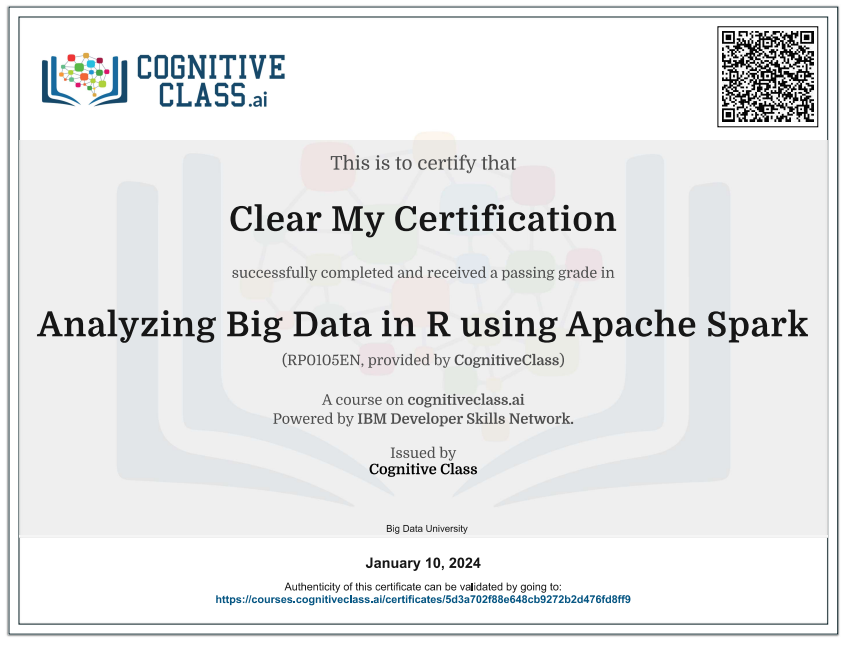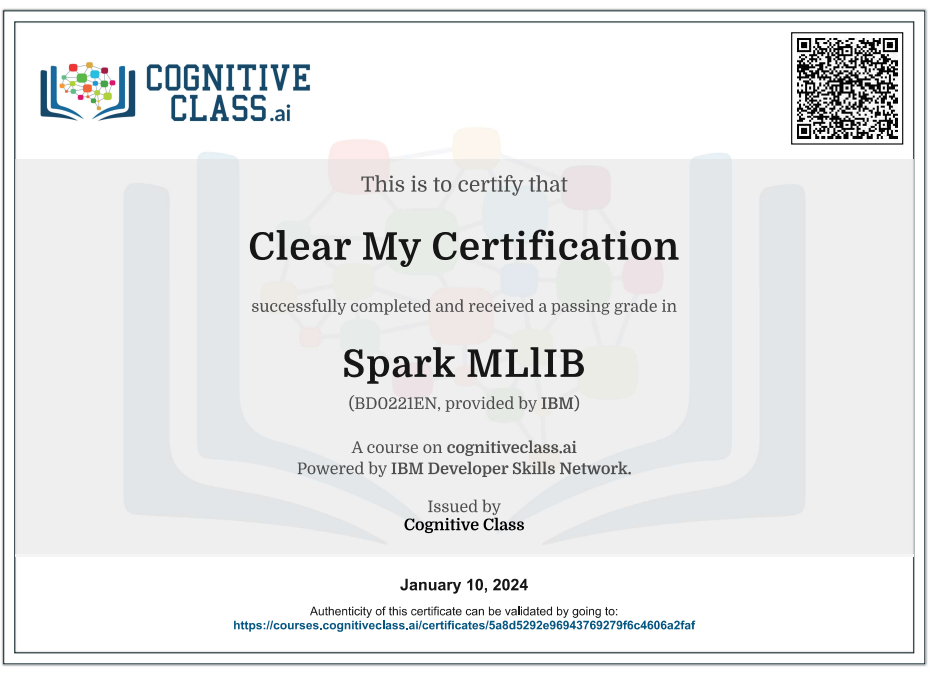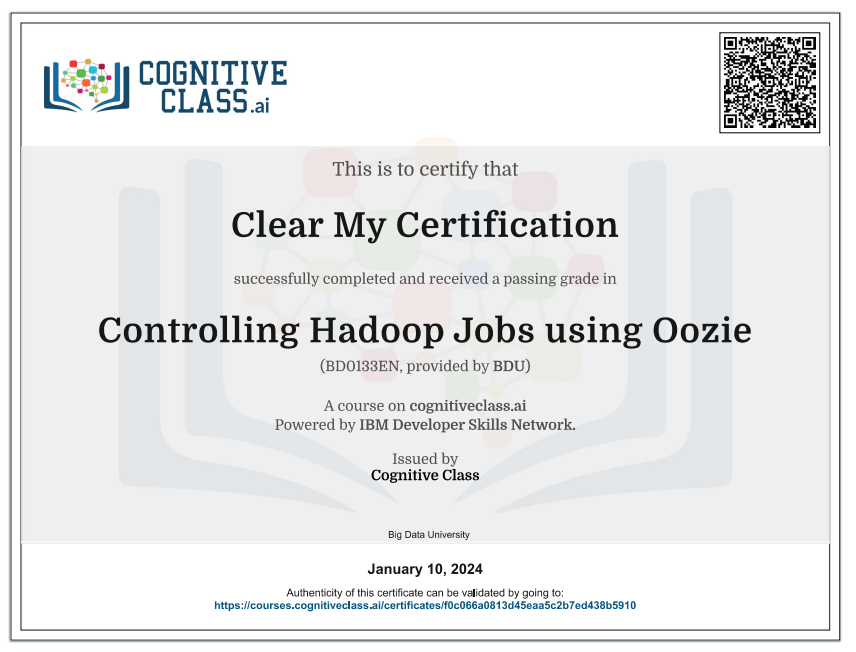Enroll Here: Mathematical Optimization for Business Problems Cognitive Class Exam Quiz Answers
Mathematical Optimization for Business Problems Cognitive Class Certification Answers

Module 1 – The Big Picture Quiz Answers – Cognitive Class
Question 1: True or false? Constraint Programming is particularly useful for solving scheduling problems and certain combinatorial optimization problems.
- False
- True
Question 2: True or false? A feasible solution can be, but is not guaranteed to be, an optimal solution.
- False
- True
Question 3: True or false? Objective functions always start with the words “maximize” or “minimize”.
- False
- True
Module 2 – Linear Programming Quiz Answers – Cognitive Class
Question 1: True or false? The following constraint is valid for a linear programming problem, where x and y are variables and z is a data item: 2x + 3y less than or equal to z²
- False
- True
Question 2: True or false? Hard constraints can be converted to soft constraints to help resolve infeasibilities.
- False
- True
Question 3: True or false? If a constraint is non-binding, its dual price will be zero.
- False
- True
Module 3 – Network Models Quiz Answers – Cognitive Class
Question 1: True or false? In a transportation problem, if all the capacities and demands are integer, then you can declare the variables to be continuous even though they are integer.
- False
- True
Question 2: True or false? The critical path is the shortest path in the network.
- False
- True
Question 3: True or false? A sequence of arcs connecting two nodes is called a path.
- False
- True
Module 4 – Beyond Simple LP Quiz Answers – Cognitive Class
Question 1: True or false? A piecewise linear function can be used to approximate convex nonlinear functions.
- False
- True
Question 2: True or false? The branch and bound method begins with LP relaxation.
- False
- True
Question 3: True or false? Mixed-integer programming is often used for investment planning.
- False
- True
Module 5 – Modelling Practice Quiz Answers – Cognitive Class
Question 1: True or false? Data sparsity can be exploited to create only the essential variables and constraints, thus reducing memory requirements.
- False
- True
Question 2: True or false? It is important to always use integer variables when a model involves the production of whole items.
- False
- True
Question 3: True or false? It is important to use penalties only when absolutely necessary.
- False
- True
Mathematical Optimization for Business Problems Final Exam Answers – Cognitive Class
Question 1: What are the two types of objects used to describe network structures?
- Nodes and arcs
- Arcs and chains
- Nodes and chains
Question 2: What are the possible reasons for an infeasible model?
- Real-world conflict
- Incorrect data
- Incorrect formulation
- All of the above
Question 3: True or false? Mathematical programming and constraint programming are the techniques you can apply using CPLEX.
- False
- True
Question 4: True or false? Binary variables are also known as Boolean variables.
- False
- True
Question 5: What is the first step of a typical optimization model development cycle?
- The identification of objectives, variables, and constraints
- The scope definition
- The creation of a prototype
Question 6: True or false? Basic variables take zero values in an iteration or final solution of the Simplex method.
- False
- True
Question 7: True or false? An unbounded variable always influences the solvability of a model.
- False
- True
Question 8: True or false? Flow conservation constraints are typically used in network models.
- False
- True
Question 9: True or false? Nonlinear terms and absolute values are not permitted in linear programming.
- False
- True
Question 10: True or false? Piecewise linear programming is used when dealing with functions consisting of several nonlinear segments.
- False
- True
Question 11: True or false? Very large linear programming models are often non-sparse.
- False
- True
Question 12: What does an optimization-based solution involve?
- An optimization engine
- Data
- An optimization model
- All of the above
Question 13: True or false? When all arcs in a chain are directed in such a way that it is possible to traverse the chain following the directions of arcs, it is called a path.
- False
- True
Question 14: A region is convex if …
- A straight line connecting two points inside the region passes outside it to get from one point to the other
- Any straight line between two points inside the region remains entirely in the region
- All of the above
Question 15: True or false? The scale of numbers used in an LP problem can affect computational time.
- False
- True
Introduction to Mathematical Optimization for Business Problems
Mathematical optimization is a powerful technique used to find the best possible solution to a problem from a set of feasible solutions. In the context of business problems, optimization is applied to make decisions that maximize or minimize an objective function, subject to a set of constraints. Here are key concepts and applications of mathematical optimization in business:
1. Linear Programming (LP):
- Definition: LP is a mathematical optimization technique for maximizing or minimizing a linear objective function, subject to linear equality and inequality constraints.
- Applications:
- Resource allocation.
- Supply chain optimization.
- Production planning and scheduling.
2. Integer Programming (IP):
- Definition: IP extends linear programming to handle discrete decision variables by restricting them to integer values.
- Applications:
- Facility location.
- Project selection.
- Binary decision problems.
3. Nonlinear Programming (NLP):
- Definition: NLP deals with optimization problems where the objective function or constraints are nonlinear.
- Applications:
- Marketing budget optimization.
- Portfolio optimization.
- Pricing strategies.
4. Mixed-Integer Nonlinear Programming (MINLP):
- Definition: MINLP combines discrete (integer) and continuous decision variables with nonlinear objective functions and constraints.
- Applications:
- Process optimization in manufacturing.
- Network design with discrete decisions.
5. Quadratic Programming (QP):
- Definition: QP involves optimizing a quadratic objective function subject to linear constraints.
- Applications:
- Portfolio optimization with quadratic risk models.
- Machine learning optimization problems.
6. Convex Optimization:
- Definition: Convex optimization deals with convex objective functions and constraints, ensuring a global optimum.
- Applications:
- Risk management in finance.
- Signal processing optimization.
7. Multi-Objective Optimization:
- Definition: Addresses problems with multiple conflicting objectives, aiming to find a set of solutions representing a trade-off.
- Applications:
- Project management with cost and time objectives.
- Supplier selection with cost and quality criteria.
8. Heuristic and Metaheuristic Optimization:
- Definition: Heuristics and metaheuristics are optimization techniques that provide good solutions for complex problems but do not guarantee optimality.
- Applications:
- Traveling Salesman Problem (TSP) in logistics.
- Vehicle routing for efficient delivery.
9. Optimization in Supply Chain:
- Inventory Management: Determining optimal inventory levels to minimize costs.
- Logistics Optimization: Route planning and warehouse management.
- Production Planning: Optimizing production schedules.
Mathematical optimization provides a systematic approach to decision-making in various business domains. It helps organizations allocate resources efficiently, improve processes, and make informed strategic decisions. When faced with complex business problems, optimization techniques offer valuable insights and solutions.
 Clear My Certification All Certification Exam Answers
Clear My Certification All Certification Exam Answers



